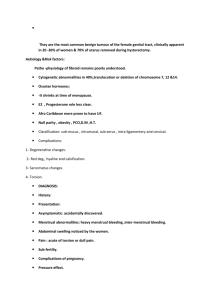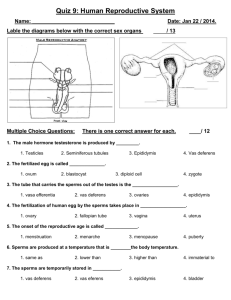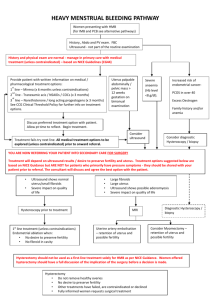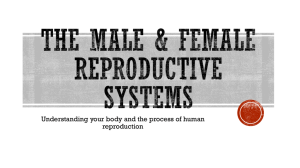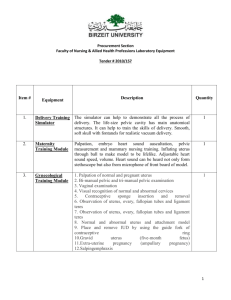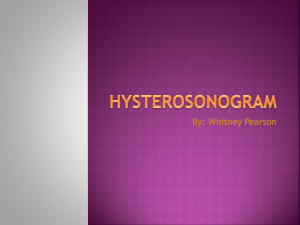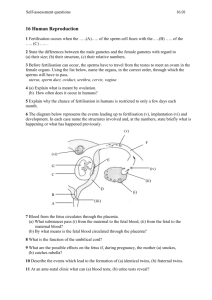female anatomy - HERS Foundation
advertisement
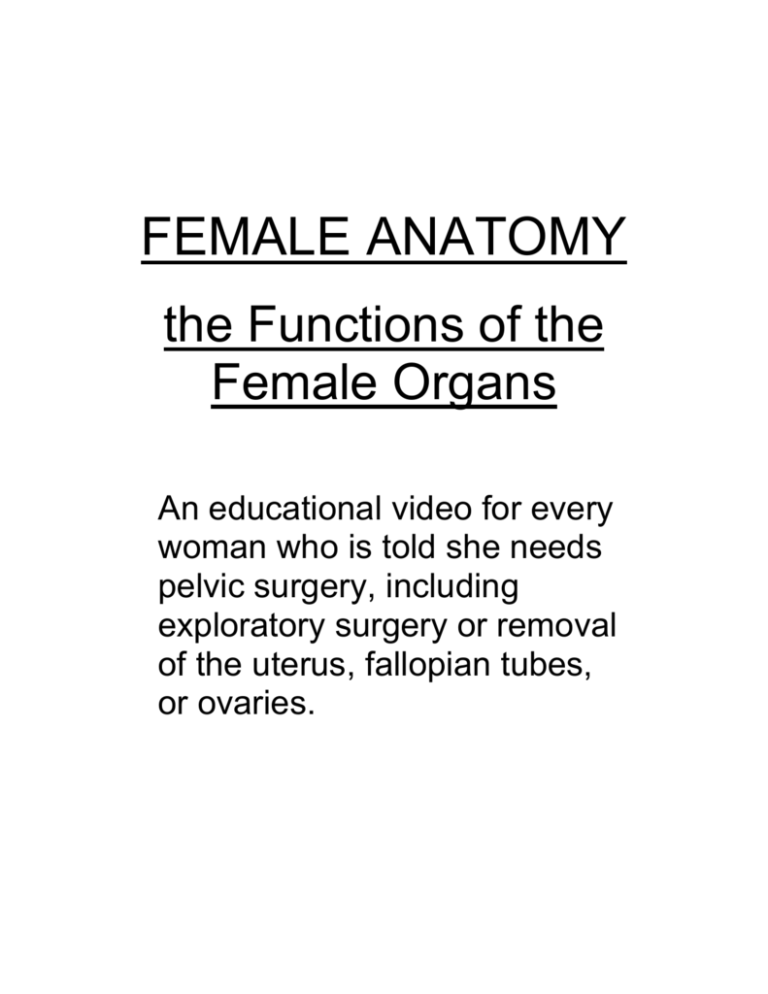
FEMALE ANATOMY the Functions of the Female Organs An educational video for every woman who is told she needs pelvic surgery, including exploratory surgery or removal of the uterus, fallopian tubes, or ovaries. produced by the HERS Foundation: Hysterectomy Educational Resources and Services an independent non-profit international women’s health education organization HERS Foundation 422 Bryn Mawr Avenue Bala Cynwyd, PA 19004 (610) 667-7757 www.hersfoundation.org © 2007 HERS Foundation 2 Video text: Because a doctor has said that you need pelvic surgery, which may include exploratory surgery and/or removal of your uterus, fallopian tubes, or ovaries, you will be asked to sign a consent form. In addition to the common risks of any major surgery—such as infection, hemorrhage, blood clots, adhesions, damage to other organs, and death—the consent form will state that you agree that you have been informed of the consequences of this particular surgery and that you understand the recommended procedure. “Informed consent” means that you have been given the necessary information to understand what you are consenting to. Whether or not you decide to proceed with the doctor’s recommendation, the factual information that follows is necessary before you sign a form that says that you are providing informed consent. This DVD includes information about: • The uterus, its functions, and its relationship to other organs • The common adverse effects of severing the nerves, ligaments, and blood supply that attach to the uterus • Ovarian function • The different types of hysterectomy • The most frequently experienced adverse effects that women report after hysterectomy The uterus is a powerful muscle located in the lower pelvis. Our first awareness of the uterus is when we are taught that it is where a baby develops during pregnancy. Later we are taught about menstruation, conception, and contraception. But that is generally where the education about the functions of the uterus ends. In fact, pregnancy is just one of the many functions of the uterus. The uterus is a hormone-responsive reproductive sex organ that supports the bladder and the bowel. The bladder sits in front of the uterus, and the bowel sits behind it. The uterus separates them and helps keep the bladder in its natural position above the pubic bone 3 and the bowel in its natural configuration behind the uterus. The uterus is continuous with the cervix, which is continuous with the vagina, much in the way that your head is continuous with your neck, which is continuous with your shoulders. When the uterus is removed, the cervix is usually removed as well. The uterus is attached to broad bands of ligaments, bundles of nerves, and networks of arteries and veins. Regardless of whether the hysterectomy is “total” or “partial,” all of the ligaments, nerves, and blood supply attached to the uterus must be severed to remove it. The round ligaments, cardinal ligaments, broad ligaments, and uterosacral ligaments that attach to the uterus provide structural integrity and support to the pelvic bones and the pelvic organs. When those ligaments are severed, women experience an unnatural shifting of the bones and organs inside the pelvis. The severing of the ligaments permits the pelvic bones to move and widen, affecting the hips, lower back, and skeletal structure. The displacement of the pelvic bones results in compression of the spine. Women report that as the spine compresses, the rib cage gradually drifts down until it sits directly on the hip bones. This compression is the reason why hysterectomized women have protruding bellies and little or no waist. Weakening of the pelvic floor and a loss of feeling from the severing of pelvic nerves may result in urinary incontinence (an inability to control urination), chronic constipation, or fecal incontinence (leakage and inability to control stool). Bladder and urinary problems are common after hysterectomy. One of the reasons for this is that when the uterus is in its natural position it provides support to the bladder. When the uterus is removed, some of that support is compromised. Bowel problems are also common. Without its natural support, the bowel moves down and takes up the space where the uterus had been. Without the uterus separating the bowel from the bladder, 4 when there is stool in the bowel it creates pressure on the bladder by pressing directly against it. The bowel bulges down creating a rectocele, which is a ballooning of the bowel into the vagina. When the nerves that attach to the uterus are severed, sensation in the vagina, clitoris, labia, and nipples is diminished or lost entirely. Many women develop a permanent searing pain of the nerve pathways that radiate down from the waist through the buttock to the back of the knee, making it painful to sit or walk. Some women experience what they describe as cyclical electric shocks in the vagina as a result of damage to the pelvic nerves. This makes it difficult to sit and often interferes with sleep and other normal activities. Physical sexual sensation is diminished or lost entirely because of the severing of nerves and the removal of the uterus. Women who experienced uterine orgasm before the surgery will not experience it after the surgery, because the uterine contractions that occur during uterine orgasm cannot occur without a uterus. The loss of uterine orgasm will only be missed by women who experienced it before the surgery. Although a small number of hysterectomized women experience slight vaginal wall contractions, most women report a total loss of sexual feeling. Severing the blood supply to the uterus diminishes the blood flow in the pelvis and to the external genitalia, including the ovaries, vagina, labia, and clitoris, as well as the legs and feet. One of the many functions of the uterus and the ovaries is cardiovascular protection. When the uterus is removed, women have a three-times greater incidence of heart disease. When the ovaries are removed, women have a seven-times greater incidence of heart disease. A woman’s ovaries—her gonads—continue to produce hormones her entire lifetime. Oophorectomy (the surgical removal of the ovaries) is performed on about 75% of the women who undergo hysterectomy. 5 The medically correct term for the removal of the gonads is castration. Because of damage to the blood supply to the ovaries, there is a loss of ovarian function in 35-40% of the women whose ovaries are not removed during hysterectomy. This too results in a loss of ovarian function, which is the same as castration. During a vaginal hysterectomy the uterus is removed through the vagina. Because the uterus is continuous with the cervix which is continuous with the vagina, the surgeon cuts into the vagina around the cervix, creating a hole in the top of the vagina. This hole must then be sutured shut, forming a closed pocket and a shortened vagina. Because the cervix is no longer there, the top of the vagina is sutured to one or more of the severed ligaments. Because the suture sometimes does not hold, hysterectomized women commonly report prolapse of the vagina out of the vaginal opening, much like a pocket that is turned inside out. During an abdominal hysterectomy, a horizontal incision is made across the pelvis above the pubic bone. Depending on the size of the uterus, it is then either pulled out through the vagina or through the pelvic incision. Total abdominal hysterectomy (TAH) and total vaginal hysterectomy (TVH) is the removal of the uterus and the cervix. Partial hysterectomy is the removal of the body of the uterus, leaving the cervical stump. A laparoscopic-assisted vaginal hysterectomy (LAVH) involves inflating the abdomen and pelvis with gas/air and removing the uterus either vaginally or by cutting it into small pieces that are pulled out through the navel (the belly button). This type of hysterectomy requires a minimum of three small incisions. It takes longer to perform than other types of hysterectomy, so there is an increased risk of complications from anesthesia, perforation of the bladder and bowel, and stress on all of the internal organs (including the heart) as a result of the pressure created by inflating the abdomen. 6 Whether TAH, TVH, or LAVH, the vagina is surgically shortened and made into a closed pocket, because the hole at the top of the vagina must be sutured shut. No matter how good the surgeon’s skill or technique, and no matter what type of hysterectomy is performed, the result is the same: a hormone-responsive reproductive sex organ is removed. The physical changes are far-reaching. The most consistent problems women experience after hysterectomy are a loss of sexual feeling, a loss of vitality, joint pain, profound fatigue, and personality change. The following adverse effects of the removal of the uterus and ovaries were reported to the HERS Foundation in an ongoing study begun in 1991: • • • • • • • • • • • • 79.6% of respondents report “loss of sexual desire” 79.6% “profound fatigue” 79.1% “personality change” 72.8% “loss of stamina” 72.1% “loss of short term memory” 70.0% “loss of ability to socialize” 65.8% “bone and joint pain” 61.5% “insomnia” 53.7% “suicidal thoughts” 49.5% “unable to maintain previous employment” 39.0% “loss of maternal feeling” 33.1% “unable to maintain activity in the home” The complete Adverse Effects Data results are available at www.hersfoundation.org. The internal female genital organs have life-long functions that can never be replaced. There is never an age or a time in a woman’s life when her uterus and ovaries are not essential to her health and wellbeing. 7 End of DVD 8


